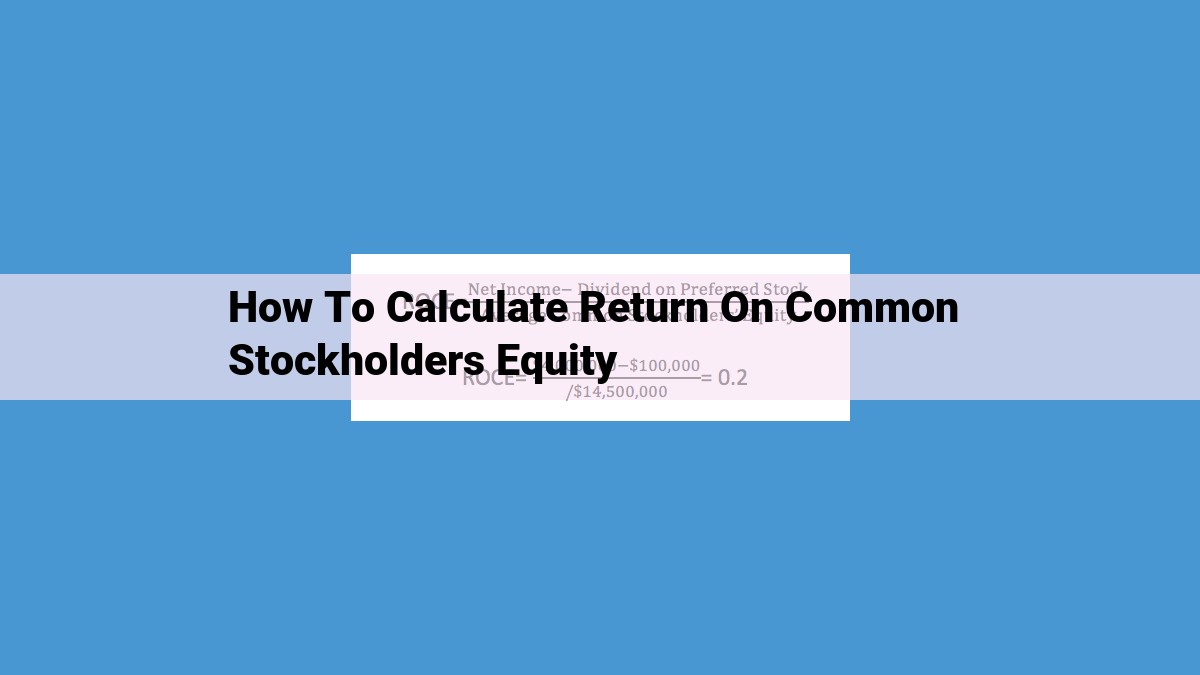To calculate return on common stockholders’ equity (ROE), first determine net income as the profit earned from revenue minus expenses. Next, calculate average common stockholders’ equity by finding the mean of equity at the beginning and end of the period. Finally, divide net income by the average common stockholders’ equity to determine ROE, which represents the percentage return earned per dollar of equity invested.
Understanding Net Income: The Foundation of Profitability
In the competitive world of business, understanding your company’s financial performance is crucial for success. Net income, often referred to as profit, represents the lifeblood of a company’s financial health. It’s the cornerstone of profitability and provides valuable insights into a business’s ability to generate revenue and manage expenses.
Defining Net Income: Revenue Minus Expenses
Net income is essentially the difference between what a company earns and what it spends. Revenue refers to the income generated from the sale of goods or services. Expenses encompass all costs incurred in the production and delivery of those goods or services. To calculate net income, simply deduct expenses from revenue.
For example, let’s say a company generates $100,000 in revenue but incurs $70,000 in expenses. The company’s net income would be $30,000, representing the profit earned from its operations.
Net Income: A Tale of Efficiency and Strategy
Net income is not just a number; it’s a measure of a company’s efficiency and strategic prowess. A high net income indicates that the company is effectively managing its expenses and maximizing revenue streams. Conversely, a low net income may suggest potential inefficiencies or challenges in generating revenue.
Monitoring Net Income: A Critical Success Indicator
Tracking net income over time is essential for monitoring a company’s financial performance. It allows businesses to identify trends, evaluate the effectiveness of their strategies, and make informed decisions to improve profitability. Regular financial reporting and analysis of net income provide valuable insights that can pave the way for sustained growth and success.
Calculating Average Common Stockholders’ Equity
Understanding a company’s financial health requires a thorough grasp of its equity, a crucial metric often overlooked. Let’s delve into the concept and explore how to calculate average common stockholders’ equity accurately.
At its core, shareholders’ equity represents the value that belongs to the company’s owners. It’s the difference between the total value of assets and the total value of liabilities, essentially what’s left over after all debts are paid off.
Common stock, a common type of equity security, represents shares of ownership held by individual investors. Each share grants the holder a proportionate claim on the company’s earnings and assets.
To determine the average common stockholders’ equity, we need to find the mean of the equity at the beginning and end of a specific period, typically a quarter or a year. Let’s illustrate this with an example.
Suppose a company has the following equity values:
- Beginning of Period: $100,000
- End of Period: $120,000
In this case, the average common stockholders’ equity would be:
(Beginning Equity + Ending Equity) / 2
= ($100,000 + $120,000) / 2
= $110,000
This result indicates that, on average, the company had $110,000 of equity available to its common stockholders during the period in question. Understanding this value provides insights into the company’s financial stability and is essential for calculating key financial ratios like Return on Common Stockholders’ Equity (ROE), which measures a company’s profitability relative to its equity investment.
Determining Return on Common Stockholders’ Equity (ROE): A Measure of Company Profitability
Have you ever wondered how companies gauge their financial performance? One key metric they rely on is Return on Common Stockholders’ Equity (ROE). ROE provides valuable insights into how well a company is leveraging its shareholders’ investments to generate profit.
Calculating ROE involves a straightforward formula: dividing net income by the average common stockholders’ equity.
$$ROE = \frac{Net\ Income}{Average\ Common\ Stockholders’\ Equity}$$
To understand this ratio, let’s break down its components. Firstly, net income represents the profit a company earns after deducting all expenses from revenue. It essentially indicates how much money the company has left after paying its bills.
Secondly, average common stockholders’ equity is the average value of the company’s assets minus its liabilities. It represents the total amount of money invested in the company by its common stockholders.
Therefore, ROE tells us the percentage return that a company earns on every dollar of equity invested by its common stockholders. A higher ROE indicates that the company is efficiently using its shareholders’ investments to generate profit. Conversely, a lower ROE suggests that the company may need to improve its profitability or allocate its resources more effectively.
ROE is a key performance indicator for investors as it provides a gauge of a company’s profitability and its ability to generate returns for shareholders. It helps them make informed decisions about whether to invest in a particular company and allows them to compare the profitability of different companies within the same industry.
